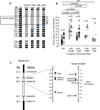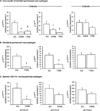Cdkn2a is an atherosclerosis modifier locus that regulates monocyte/macrophage proliferation
- PMID: 21868699
- PMCID: PMC3350106
- DOI: 10.1161/ATVBAHA.111.234492
Cdkn2a is an atherosclerosis modifier locus that regulates monocyte/macrophage proliferation
Abstract
Objective: Common genetic variants in a 58-kb region of chromosome 9p21, near the CDKN2A/CDKN2B tumor suppressor locus, are strongly associated with coronary artery disease. However, the underlying mechanism of action remains unknown.
Methods and results: We previously reported a congenic mouse model harboring an atherosclerosis susceptibility locus and the region of homology with the human 9p21 locus. Microarray and transcript-specific expression analyses showed markedly decreased Cdkn2a expression, including both p16(INK4a) and p19(ARF), but not Cdkn2b (p15(INK4b)), in macrophages derived from congenic mice compared with controls. Atherosclerosis studies in subcongenic strains revealed genetic complexity and narrowed 1 locus to a small interval including Cdkn2a/b. Bone marrow (BM) transplantation studies implicated myeloid lineage cells as the culprit cell type, rather than resident vascular cells. To directly test the role of BM-derived Cdkn2a transcripts in atherogenesis and inflammatory cell proliferation, we performed a transplantation study using Cdkn2a(-/-) cells in the Ldlr(-/-) mouse model. Cdkn2a-deficient BM recipients exhibited accelerated atherosclerosis, increased Ly6C proinflammatory monocytes, and increased monocyte/macrophage proliferation compared with controls.
Conclusion: These data provide a plausible mechanism for accelerated atherogenesis in susceptible congenic mice, involving decreased expression of Cdkn2a and increased proliferation of monocyte/macrophages, with possible relevance to the 9p21 human locus.
Figures





Similar articles
-
Enhanced Megakaryopoiesis and Platelet Activity in Hypercholesterolemic, B6-Ldlr-/-, Cdkn2a-Deficient Mice.Circ Cardiovasc Genet. 2016 Jun;9(3):213-22. doi: 10.1161/CIRCGENETICS.115.001294. Epub 2016 Apr 20. Circ Cardiovasc Genet. 2016. PMID: 27098250 Free PMC article.
-
Expression of Chr9p21 genes CDKN2B (p15(INK4b)), CDKN2A (p16(INK4a), p14(ARF)) and MTAP in human atherosclerotic plaque.Atherosclerosis. 2011 Feb;214(2):264-70. doi: 10.1016/j.atherosclerosis.2010.06.029. Epub 2010 Jun 23. Atherosclerosis. 2011. PMID: 20637465
-
Functional analyses of coronary artery disease associated variation on chromosome 9p21 in vascular smooth muscle cells.Hum Mol Genet. 2012 Sep 15;21(18):4021-9. doi: 10.1093/hmg/dds224. Epub 2012 Jun 15. Hum Mol Genet. 2012. PMID: 22706276 Free PMC article.
-
Islet biology, the CDKN2A/B locus and type 2 diabetes risk.Diabetologia. 2016 Aug;59(8):1579-93. doi: 10.1007/s00125-016-3967-7. Epub 2016 May 7. Diabetologia. 2016. PMID: 27155872 Free PMC article. Review.
-
Functional genomics of the 9p21.3 locus for atherosclerosis: clarity or confusion?Curr Cardiol Rep. 2014 Jul;16(7):502. doi: 10.1007/s11886-014-0502-7. Curr Cardiol Rep. 2014. PMID: 24893939 Review.
Cited by
-
Expanded granulocyte/monocyte compartment in myeloid-specific triple FoxO knockout increases oxidative stress and accelerates atherosclerosis in mice.Circ Res. 2013 Mar 29;112(7):992-1003. doi: 10.1161/CIRCRESAHA.112.300749. Epub 2013 Feb 18. Circ Res. 2013. PMID: 23420833 Free PMC article.
-
Senescent intimal foam cells are deleterious at all stages of atherosclerosis.Science. 2016 Oct 28;354(6311):472-477. doi: 10.1126/science.aaf6659. Epub 2016 Oct 27. Science. 2016. PMID: 27789842 Free PMC article.
-
Methylation of p15INK4b and expression of ANRIL on chromosome 9p21 are associated with coronary artery disease.PLoS One. 2012;7(10):e47193. doi: 10.1371/journal.pone.0047193. Epub 2012 Oct 16. PLoS One. 2012. PMID: 23091611 Free PMC article.
-
Loss of CDKN2B promotes p53-dependent smooth muscle cell apoptosis and aneurysm formation.Arterioscler Thromb Vasc Biol. 2013 Jan;33(1):e1-e10. doi: 10.1161/ATVBAHA.112.300399. Epub 2012 Nov 15. Arterioscler Thromb Vasc Biol. 2013. PMID: 23162013 Free PMC article.
-
Review: Experimental models for Barrett's esophagus and esophageal adenocarcinoma.Am J Physiol Gastrointest Liver Physiol. 2012 Jun 1;302(11):G1231-43. doi: 10.1152/ajpgi.00509.2011. Epub 2012 Mar 15. Am J Physiol Gastrointest Liver Physiol. 2012. PMID: 22421618 Free PMC article. Review.
References
-
- McPherson R. Chr 9p21 and coronary artery disease. N Engl J Med. 2010;362:1736–1737. - PubMed
-
- Schunkert H, Konig IR, Kathiresan S, Reilly MP, Assimes TL, Holm H, Preuss M, Stewart AF, Barbalic M, Gieger C, Absher D, Aherrahrou Z, Allayee H, Altshuler D, Anand SS, Andersen K, Anderson JL, Ardissino D, Ball SG, Balmforth AJ, Barnes TA, Becker DM, Becker LC, Berger K, Bis JC, Boekholdt SM, Boerwinkle E, Braund PS, Brown MJ, Burnett MS, Buysschaert I, Carlquist JF, Chen L, Cichon S, Codd V, Davies RW, Dedoussis G, Dehghan A, Demissie S, Devaney JM, Diemert P, Do R, Doering A, Eifert S, Mokhtari NE, Ellis SG, Elosua R, Engert JC, Epstein SE, de Faire U, Fischer M, Folsom AR, Freyer J, Gigante B, Girelli D, Gretarsdottir S, Gudnason V, Gulcher JR, Halperin E, Hammond N, Hazen SL, Hofman A, Horne BD, Illig T, Iribarren C, Jones GT, Jukema JW, Kaiser MA, Kaplan LM, Kastelein JJ, Khaw KT, Knowles JW, Kolovou G, Kong A, Laaksonen R, Lambrechts D, Leander K, Lettre G, Li M, Lieb W, Loley C, Lotery AJ, Mannucci PM, Maouche S, Martinelli N, McKeown PP, Meisinger C, Meitinger T, Melander O, Merlini PA, Mooser V, Morgan T, Muhleisen TW, Muhlestein JB, Munzel T, Musunuru K, Nahrstaedt J, Nelson CP, Nothen MM, Olivieri O, Patel RS, Patterson CC, Peters A, Peyvandi F, Qu L, Quyyumi AA, Rader DJ, Rallidis LS, Rice C, Rosendaal FR, Rubin D, Salomaa V, Sampietro ML, Sandhu MS, Schadt E, Schafer A, Schillert A, Schreiber S, Schrezenmeir J, Schwartz SM, Siscovick DS, Sivananthan M, Sivapalaratnam S, Smith A, Smith TB, Snoep JD, Soranzo N, Spertus JA, Stark K, Stirrups K, Stoll M, Tang WH, Tennstedt S, Thorgeirsson G, Thorleifsson G, Tomaszewski M, Uitterlinden AG, van Rij AM, Voight BF, Wareham NJ, Wells GA, Wichmann HE, Wild PS, Willenborg C, Witteman JC, Wright BJ, Ye S, Zeller T, Ziegler A, Cambien F, Goodall AH, Cupples LA, Quertermous T, Marz W, Hengstenberg C, Blankenberg S, Ouwehand WH, Hall AS, Deloukas P, Thompson JR, Stefansson K, Roberts R, Thorsteinsdottir U, O'Donnell CJ, McPherson R, Erdmann J, Samani NJ. Large-scale association analysis identifies 13 new susceptibility loci for coronary artery disease. Nat Genet. 2011;43:333–338. - PMC - PubMed
-
- Samani NJ, Erdmann J, Hall AS, Hengstenberg C, Mangino M, Mayer B, Dixon RJ, Meitinger T, Braund P, Wichmann HE, Barrett JH, Konig IR, Stevens SE, Szymczak S, Tregouet DA, Iles MM, Pahlke F, Pollard H, Lieb W, Cambien F, Fischer M, Ouwehand W, Blankenberg S, Balmforth AJ, Baessler A, Ball SG, Strom TM, Braenne I, Gieger C, Deloukas P, Tobin MD, Ziegler A, Thompson JR, Schunkert H. Genomewide association analysis of coronary artery disease. N Engl J Med. 2007;357:443–453. - PMC - PubMed
-
- Helgadottir A, Thorleifsson G, Manolescu A, Gretarsdottir S, Blondal T, Jonasdottir A, Sigurdsson A, Baker A, Palsson A, Masson G, Gudbjartsson DF, Magnusson KP, Andersen K, Levey AI, Backman VM, Matthiasdottir S, Jonsdottir T, Palsson S, Einarsdottir H, Gunnarsdottir S, Gylfason A, Vaccarino V, Hooper WC, Reilly MP, Granger CB, Austin H, Rader DJ, Shah SH, Quyyumi AA, Gulcher JR, Thorgeirsson G, Thorsteinsdottir U, Kong A, Stefansson K. A common variant on chr 9p21 affects the risk of myocardial infarction. Science. 2007;316:1491–1493. - PubMed
Publication types
MeSH terms
Substances
Grants and funding
LinkOut - more resources
Full Text Sources
Medical
Molecular Biology Databases
Miscellaneous

